What is Enhanced Survey Programme (ESP)?
The history of the types of ships such as bulk carriers and tankers is filled with accidents and disasters, both of small-scale and gruesome types. Many of these accidents were a result of faulty machinery or lack of safe handling practices which forced the maritime authorities to introduce a particular survey type know an ESP or Enhanced Survey Programme.
IMO adopted a resolution A 744 (18) in 1994 SOLAS conference with guidelines on the Enhanced survey programme for inspection and surveys of bulk carriers and tankers.
Related Reading: 9 Common Hazards Of Dry Bulk Cargo On Ships
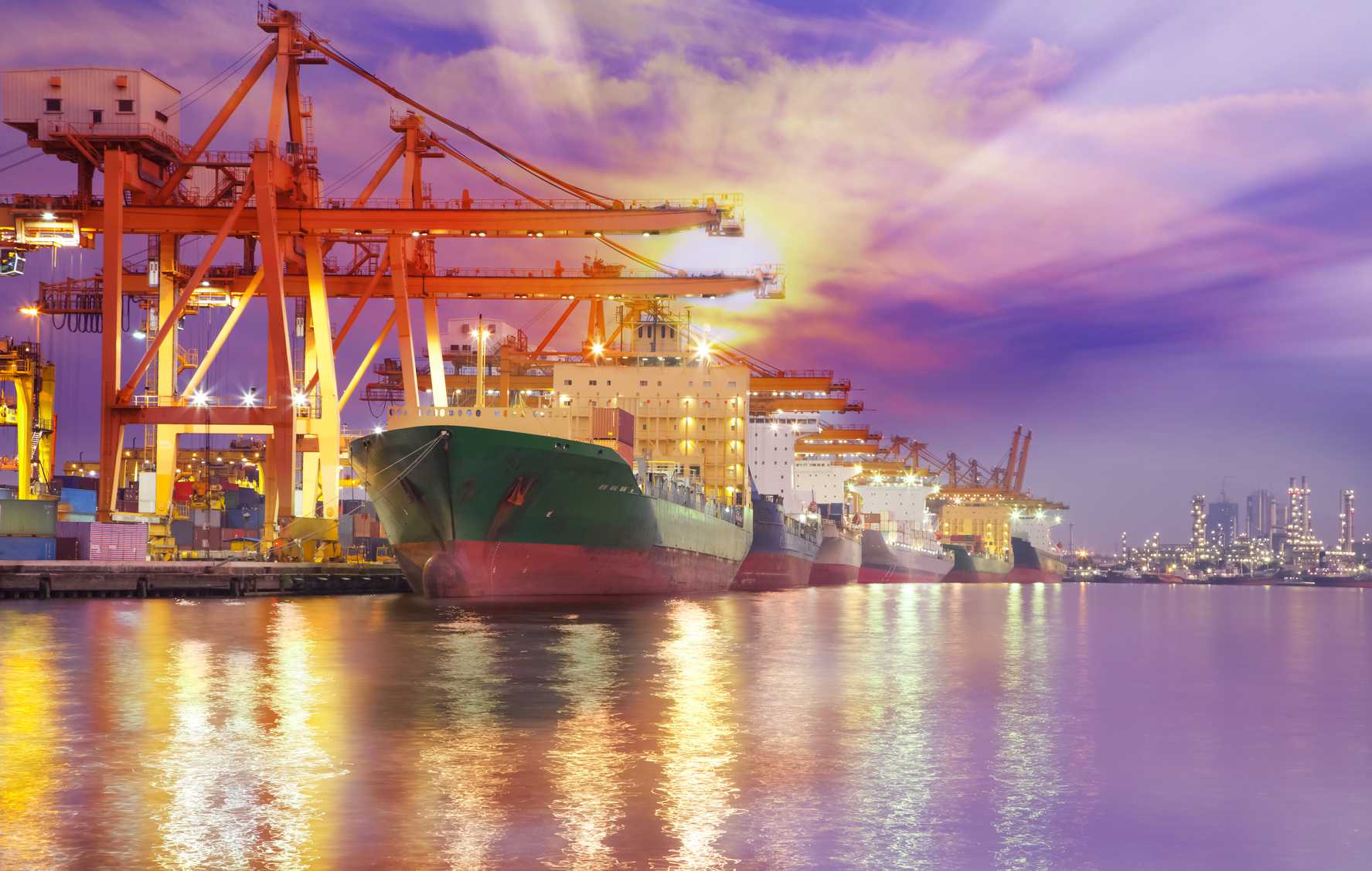
What is Enhanced Survey Programme?
Enhanced survey programme is a guideline for shipping companies and owners to prepare their ships for special surveys to maintain the safety of the vessel while at sea or at a port. A survey programme (a Planning document for surveying and paperwork) is to be developed by the owner and is to be submitted to the recognised authorities such as classification societies, 6 months before the survey.
Related Reading: List of inspections and surveys deck officers on a ship must be aware of
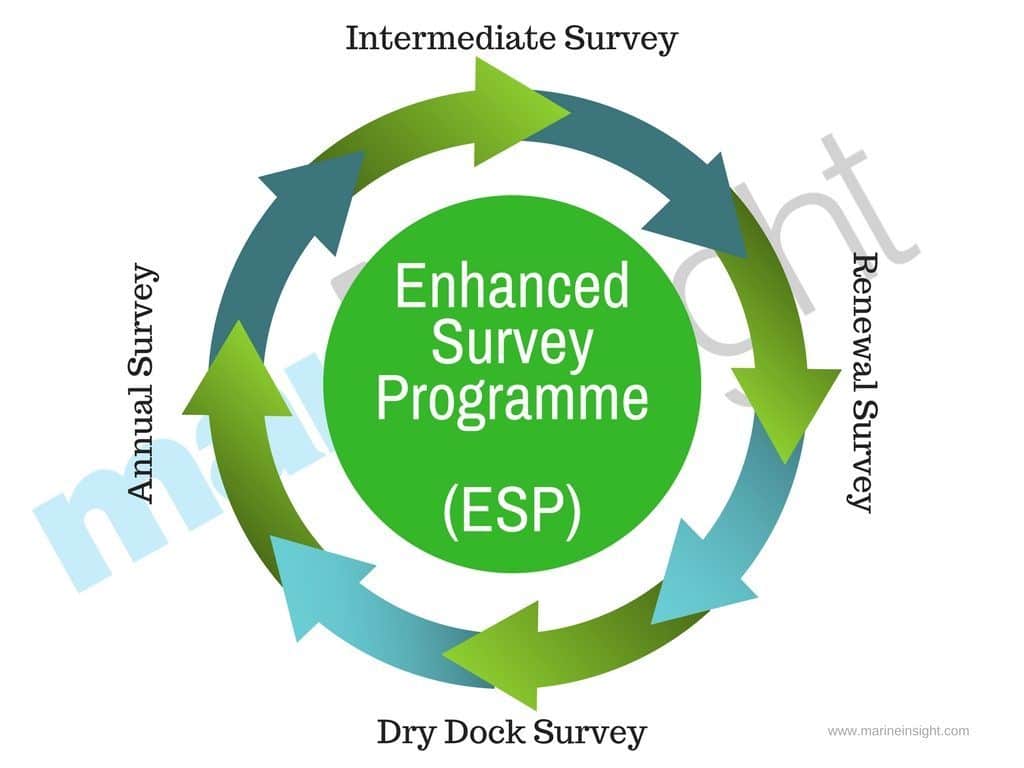
Enhanced Survey programme is developed in such a way that it can be integrated with other surveys which are performed at following intervals:
– Annual
– Intermediate Survey
– Dry Dock Survey
– Renewal Survey
For a company to comply and perform an ESP or an enhanced survey program, it needs to design an enhanced survey programme, which must include the step by step planning to implement the special survey. It can be said that the ESP is conducted to check the watertight integrity of the ship by inspecting the following areas of the ship:
– Close-up survey of the structures such as Shell, frames, bulkheads etc.
– Thickness measurement of hull
– Inspecting and Testing of Cargo Tanks
– Inspecting and Testing of Ballast Tanks
– Inspection and Testing of Hatch Covers and Coamings
– Inspecting and Testing fuel tanks, side and double bottom Tanks
Related Reading: Inspecting Tanks On Board Ships
What to check in ESP?
- Ship’s structural damage or deformation
- Corrosion
- Condition of Hull
- Pitting
- Condition of Coating
- Watertight Integrity of ship
After the survey, following reports are made by the inspector, whose copies are to be kept and maintained onboard as part of necessary documentation:
- Reports of structural surveys
- Condition evaluation report
- Thickness measurement reports
As mentioned earlier, the Enhance Survey Programme (ESP) is designed to monitor the different types of ships listed below for their construction and safe operation:
- Oil tankers which are single and double hull: Oil tankers constructed with integral tanks and are intended primarily to carry oil in bulk. The oil tankers can be of both single and double hull construction, as well as tankers with alternative structural arrangements, e.g. mid-deck designs.
Related Reading: Understanding Design Of Oil Tanker Ships
- Single and double-side skin bulk carriers: Ships with a single deck, double bottom, hopper side tanks and topside tanks and with single or double side skin construction in cargo length area and intended primarily to carry dry cargoes in bulk.
Related Reading: Understanding Design Of Bulk Carriers
- Ore carriers: Ore Carriers with a single deck, two longitudinal bulkheads and a double bottom throughout the cargo length area and intended primarily to carry ore cargoes in the centre holds only.
Combination carriers (OBO ship): Combination ship are constructed with a single deck, two longitudinal bulkheads and a double bottom throughout the cargo length area and intended primarily to carry ore cargoes in the centre holds or of oil cargoes in the centre holds and wing tanks.
- Chemical tankers: The Chemical tanker ship with integral tanks and intended primarily to carry chemicals in bulk. They can be of single or double hull construction, as well as tankers with alternative structural arrangements.
Related Reading: Stowage Plan Guide For Chemical Tankers
A new chapter XI is added for special measures to enhance maritime safety under this resolution. According to these guidelines, it has 2 Annexes:
- Annex A: Guidelines on enhancing survey programme of inspection during survey of bulk carrier.
- Annex B: Guidelines on enhancing survey programme of inspection during survey of oil tankers.
Each annex A & B has 9 chapters which are almost similar. The only dissimilarities being operational and constructional aspects of both type of vessels i.e. oil tankers and bulk carriers.
The chapters can be briefly described as:
Chapter 1: General application, documentation onboard to be completed prior to the inspection which is to be served as basis for surveys.
Chapter 2: Describes how Enhanced survey to be carried out during the periodical surveys along with timings and conduct of enhance surveys and requirements of dry-docking.
Related Reading: Dry Docking of Ships: Understand Stability and Docking Plan
Chapter 3: Describes enhanced inspection carried out during annual surveys which includes cargo holds and tank pressure testing.
Chapter 4: Deals with intermediate surveys in addition to the annual survey requirements.
Chapter 5: Discuss the needed preparation for surveys, condition and equipment for surveys, access to the surveyed structure and conduct of survey at sea or at anchor
Chapter 6: Immediate and thorough repairs to damages and wastages.
Chapter 7: Discuss the requirement of onboard documents supplied and maintained by the owner that must be available to the surveyor and requirements for survey report file, supporting documents, review of document by surveyor.
Chapter 8: Discuss the process of reporting and evaluation of survey, acceptability and continued structural integrity, a condition evaluation report of the survey and results to be issued to the owner.
Chapter 9: Reporting and evaluation of surveys, acceptable and continued structural integrity; a condition evaluation report of the survey and results to be issued to the owner.
These are the chapters mentioned in both the Annexes. To know more about ESP refers SOLAS.
What are the Inspection Interval and Requirements under ESP?
♣ On bulk carrier ships and tanker ships of 20,000 tons deadweight and above, at least two class surveyors must carry out the special survey once the vessel is 10 years old during all the renewal surveys.
♣ On single side skin bulk carriers of 100,000 tons deadweight and above, at least two exclusive Surveyors must jointly perform the Intermediate Survey between 10 and 15 years of ships’ age
♣ The survey in the dry-dock to be integrated as a part of the renewal survey with a minimum of two inspections of the outside of the ship’s bottom during the five-year period of the certificate. In all cases, the maximum interval between bottom inspections should not exceed 36 months.
Related Reading: Hull Of A Ship – Understanding Design and Characteristics
♣ For a new ship, the renewal survey can be started at the fourth annual survey and can be progressed during the succeeding year with an aim to complete the survey by the fifth-anniversary date. The thickness measurement should not be held before the fourth annual survey.
♣ In any survey, i.e. renewal, intermediate, annual or other surveys having the scope of the preceding ones, thickness measurements of structures in areas where close-up surveys are required should be carried out simultaneously with close-up surveys.
How To Design an Enhanced Survey Programme?
The Shipping company will draw a planning document which will be submitted to the recognised classification society for approval.
The essential data provided in the plan are:
- Necessary ship information and particulars
- Main structural plans (scantling drawings), including information regarding the use of high tensile steels (HTS)
- Plan of holds and tanks
- List of holds and tanks with information on use, protection, and condition of the coating
Related Reading: Procedure For Designing A Ship’s General Arrangement
- Requirements for the survey (e.g., data regarding hold and tank cleaning, gas freeing, ventilation, lighting, etc.)
- Provisions and methods for access to structures
- Equipment for survey
- Appointing the holds, tanks and other areas for the close-up survey
- Appointing of sections for thickness measurement
- Appointing of tanks for tank testing.
- Damage experience related to the ship in question.
The Plan approval and survey takes place once the Class assesses the report in the following pattern:
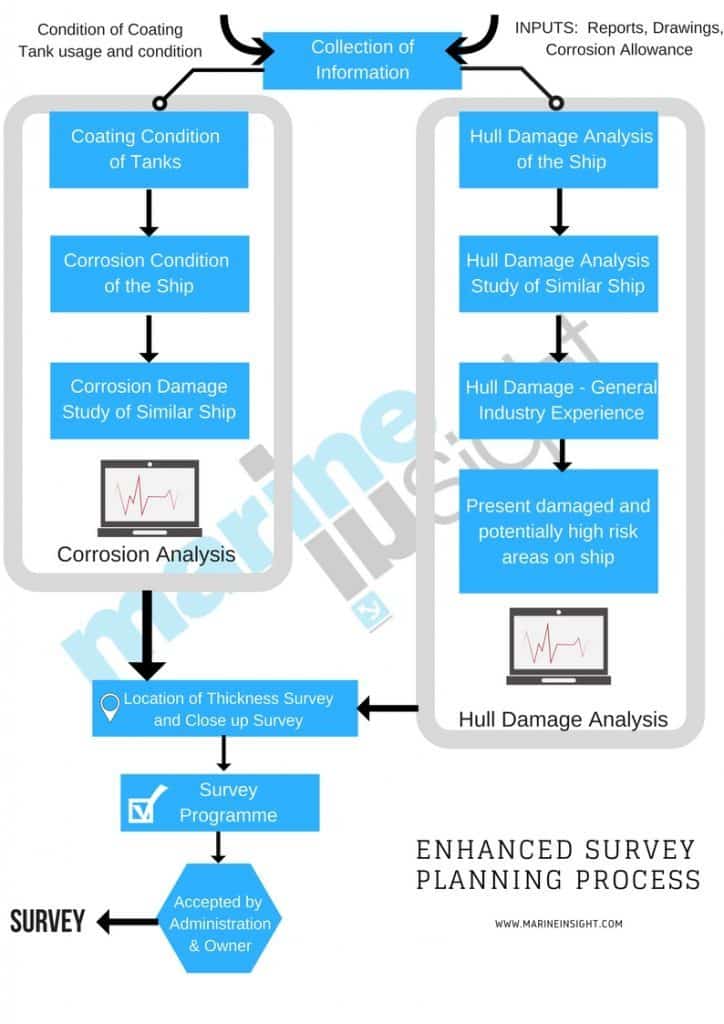
What is the role of ship’s Crew In ESP?
– The Master of the ship needs to report the results of the inspection and record the same in the ship’s logbook. The data recorded should clearly identify the tank, compartment or cargo hold subjected to testing along with a date, time and outcome of the inspections carried out during the testing
– Before the survey is carried out, a Survey planning meeting within the ship crew and another one with the surveyor and the owner’s representative (usually the ship crew) to be conducted to ensure clear communication between all parties during inspection
Related Reading: How team meetings help in improving safety and efficiency of the ships?
– If during the survey, a qualified individual is present for thickness measurement, all-party meeting to be carried out before the investigation to ensure the safe and efficient conduct of the survey
– The crew needs to comply with various SOLAS regulations under ESP and provide permanent or temporary staging and passages through structures to ensure surveyor has access to all the areas under inspection
– Equipment for the survey (for thickness measurement etc.) is usually carried by the surveyor or by the appointed shore representative but other small required equipment and tools to be arranged and kept ready by the ship’s crew
– The crew must arrange a communication system between the survey party in the survey space and the responsible officer on deck
– If the survey is carried out at sea in a boat or life raft, proper communication and life-saving equipment like lifejacket must be readily available on deck for all participants
– One responsible officer must accompany the surveyor in enclosed space for survey only after all enclosed space entry precautions have been followed
Related Reading: Confined Space Guide
– Ship Officer must ensure that the survey report file is maintained as a part of the onboard documentation.
– Apart from the survey report, following supporting documentation to be maintained by the ship’s crew under ESP which will be helpful for the surveyor for conducting the next survey:
- Ship’s main structural plans of the cargo hold and ballast tank Previous repair history of ship structure
- Previous repair history of cargo and ballast tanks
- Previous inspections report by ship’s personnel concerning structural deformation (cracks, leakages in bulkheads and piping etc.)
- Coating condition of tanks and other ship structures including the corrosion prevention system
- Guidance for reporting the defect
- Any additional information that would help to identify critical structural areas and/or suspect areas requiring inspection
Survey Report
The result of the survey mainly targets the Structural condition of each compartment with information on the following identifications:
– Corrosion with a description of the location, type and extent
– Areas with substantial corrosion
– Cracks/fractures with a description of position and scale
– Buckling with a description of location and extent
– Indents with a description of location and extent
– Identification of compartments where no structural damages/defects are found.
Related Reading: Why Do Ships Fail At Mid Ship Region?
The report is usually supplemented by sketches and photos as proof and reference. The thickness measurement report must be verified and signed by the surveyor controlling the measurements on board.
The surveyor will provide the report with remarks to the owner or owner’s representative on actions required to conclude the survey (i.e. concerning Overall surveys, Close-up surveys, renewals, repairs, and conditions of class).
Disclaimer: The authors’ views expressed in this article do not necessarily reflect the views of Marine Insight. Data and charts, if used, in the article have been sourced from available information and have not been authenticated by any statutory authority. The author and Marine Insight do not claim it to be accurate nor accept any responsibility for the same. The views constitute only the opinions and do not constitute any guidelines or recommendation on any course of action to be followed by the reader.
The article or images cannot be reproduced, copied, shared or used in any form without the permission of the author and Marine Insight.
Do you have info to share with us ? Suggest a correction

About Author
An ardent sailor and a techie, Anish Wankhede has voyaged on a number of ships as a marine engineer officer. He loves multitasking, networking, and troubleshooting. He is the one behind the unique creativity and aesthetics at Marine Insight.
Latest Maritime law Articles You Would Like:
Latest News
- What is the Purpose of DG Shipping?
- What are Logistics Risks?
- How Port and Terminal Operators Can Control Emissions?
- Minimum Quantity Commitment (MQC) and Liquidated Damages in Container Shipping: Concept and Relevance
- MARPOL (The International Convention for Prevention of Marine Pollution For Ships): The Ultimate Guide
- The Ultimate Shipping Container Dimensions Guide
Subscribe To Our Newsletters
By subscribing, you agree to our Privacy Policy and may receive occasional deal communications; you can unsubscribe anytime.



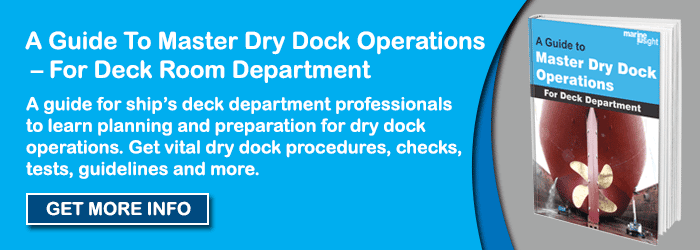
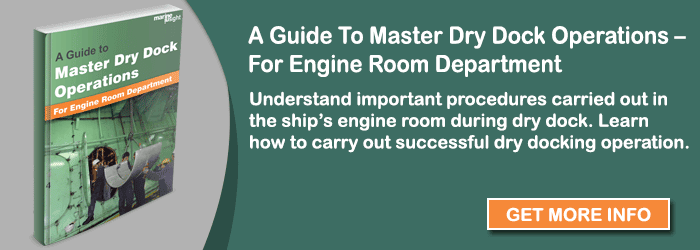

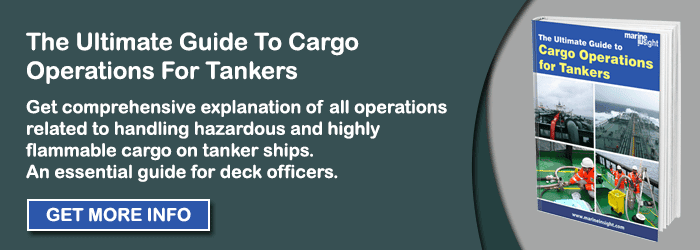













I request you to send I M O Details and latest information about vessels daily to my email id.
with regds,
AS Panse
Oceanic Enterprises
F-3, II Floor, Marine Towers, Old Lakshmi Talkies, Visakhapatnam-1.
Dear Sir,
You need to subscribe to our daily newsletter for that. You can find the “subscription box” at the end of every article.
Hope this helps.
Regards
Raunek k
Sir ,
I want to know why this esp is carried out for bulk and tankers and not for other ships.
Dear sir I want to know any difference between special survey and enhance survey programme. More let me clear harmonized and docking survey ….
thanks a lot.
THANKS
could you pls let us know, is this ESP applicable only for bulk carriers and oil tankers?
is there any kind of programs for other vessels such as container? and if any what are the methods of enhancing the survey prior to carrying out annual survey?
thanks and best regards!!!
How would i know that my ship required ESP
As of now Enhanced survey programme applies to bulk carriers and oil tankers irrespective of the age of the ship.